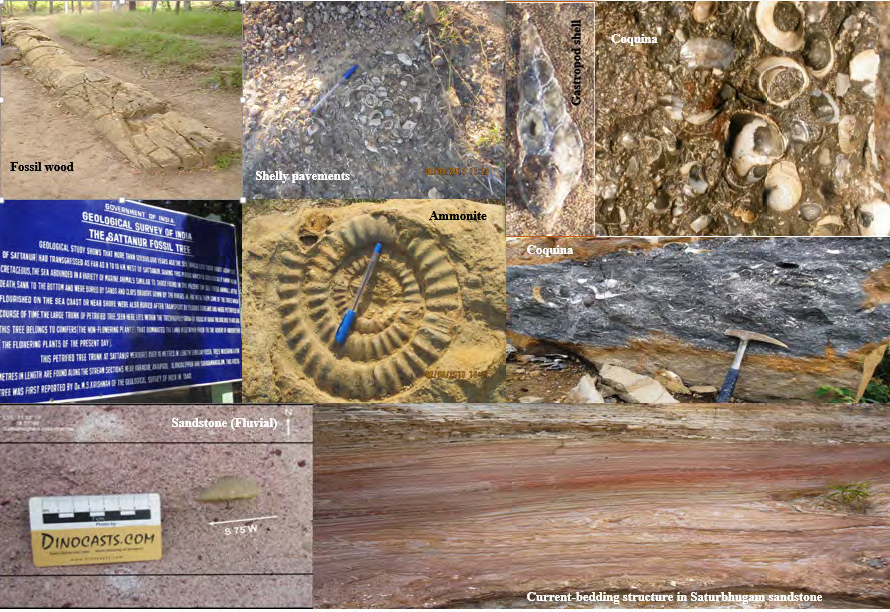Garudamangalam Fm
Type Locality and Naming
ARIYALUR-TRICHIRAPPALLI OUTCROP: Named after Garudamangalam village, Ariyalur district, TamilNadu. Type locality = Kulakkalnattam-Anaipadi-Alandiapur-Saturbhugam-Garudamangalam villages, Ariyalur district.
[Figure 1: Geologic map of Ariyalur area]
Lithology and Thickness
Sandstone. This Formation has distinct three members. The lower Kulakkalnattam Sandstone Member is bioturbated sandstone beds ranging into sandy coquina. The middle Anaipadi Calcarenite Member comprises of concretionary siltstone, mudstone and fine micaceous sandstone, bioturbated. The upper Saturbhugam Sandstone Member comprises of sandstone with well-preserved current bedding and un-decomposed feldspar grains, non-fossiliferous, of a fluvial provenance.
[Figure 2: Field photos of lithology and fossils of Garudamangalam Formation. Top row: Fossil wood, Shale pavements, Coquina. Middle row: Sign, Ammonite, Coquina. Bottom row: Sandstone (fluvial), Current bedding structure in Saturbhugam sandstone Member (provided by A. Nallapa Reddy and R. Nagendra)]
Relationships and Distribution
Lower contact
Unconformable on the Karai Fm. This unconformity spans the Late Turonian.
Within the formation, the Kulakkalnattam Sandstone Member is conformably followed by the Anaipadi Calcarenite Member.
Upper contact
Unconformable contact with Campanian Sillakkudi Fm. This unconformity, spanning the late Santonian, is present between the fluvial-facies Saturbhugam Sandstone Member of the Garudamangalam Fm and the overlying Sillakkudi Fm. During this period the basin appears to be under erosive and/ or fluvial regime. The occurrence of fresh feldspar and sandstone clasts suggests incision into older facies and defined as sequence boundary at the base of this unit (Tewari et al., 1996 and Nagendra et al., 2011).
Regional extent
Garudamangalam Formation extends in NS distribution in Geological map of Ariyalur area (Trichinopoly). Its equivalents are extending in the dip direction of the subsurface.
GeoJSON
Fossils
Fossil driftwood occurs in basal part of the formation. Significant fossil wood of 18 m length is well preserved in Sattanur village. This is lying in the plane of bedding and orientated north-south subparallel to the strike trends and inferred orientation of the paleo-strand line (Sundaram et al, 2001).
The Anaipadi Member contains ammonites of the Lewesiceras Zone (Sastry et al. 1968) and Kossmaticeras thebaldianaum Zone. In addition, Lamellibranchs and Trace fossils Thalassionoides, Ophiophorpha is reported (Tewari et al., 1996 and Nagendra et al., 2010,)
Well-preserved ichnofossils in Kulakkalnattam Sandstone Member of Garudamangalam Formation are of infaunal structures of both suspension and deposit feeders. Five ichnofossils are present in coarse-grained sandstone, they are Ophiomorpha, Palaeophycus, Planolites, Skolithos and Thalassinoides. Ophiomorpha infers a high energy condition in shifting substrate, whereas Thalassinoides and Planolites indicate infaunal deposit feeders living at the sediment-water interface in low to moderate energy conditions which lead development of Skolithos and Cruziana ichnofacies type condition during the deposition of Sandstone in foreshore-shoreface environments (Nagendra et.al., 2010).
Age
Depositional setting
Garudamangalam Formation forms a highstand systems tract, and has a wide range of siliciclastic-carbonate mixing modes in a nearshore marine realm associated with a river-mouth bar. Clean, well-sorted, bioturbated sandstone, and shell bearing concretions at the base of the succession, locally contain drift-wood is representative of transgressive, littoral to shallow marine environment developed atop an erosion surface of the Karai Fm. The occurrence of current-worked, diverse shell beds with well-sorted sand matrices interlayered with fine-grained siliciclastic beds in the upper part of the unit suggests shallow shelf deposition under fluctuating hydrodynamics conditions with the higher energy regime sponsoring the formation of shelly pavements. The Anaipadi Member with diversified cephalopods and benthos represents the distal shelf deposition in deeper water than upper portion of the underlying Kulakkalnattam Sandstone Member. The abundance of shelly benthos and sporadic occurrence of current worked coquinas suggest that deposition was still within a neritic zone. The coarsening upwards suggests that its sequence reflects a shoaling, regressive trend (Sundaram et al., 2001)
Although deposition took place in a narrow belt, paleoenvironment conditions differed widely. The presence of a shore-parallel river-mouth bar resulted in a restricted environment on its shoreward side, while its seaward side remained open marine. A connection between the two contrasting energy regimes was maintained by one or more tidal inlets. The shoreline alignment being almost north- south, the marked energy contrast was more outspoken in a roughly east-west transect. The mixing modes are depositional and diagenetic. In both categories the mixing modes are biogenic as well as abiogenic. The most common mode of mixing is at the transition between two laterally adjacent facies of contrasting compositions. In any natural setting, the contact between two indigenous facies is always blurred because of mixing of their constituents and does not merit search for any other tortuous explanation for the mixing. Patchy build-ups of colonies of calcium carbonate secreting organisms within siliciclastic depositional settings may not be favored, but are not un-common either. Isolated mesoscale patches of rudist colonies and microscale mounds of red algae within sandstones are examples. Mixing also took place when silt-sized dust settled from the air onto an indigenous carbonate mudflat. An admixture of siliceous and carbonate clastics often arose because of simultaneous transport of both components by the same current. Different settling behaviors, however, generally segregated the two components in two different parts of the beds. Preferred accumulations of carbonate shells at the bottom of the beds, both as traction and as suspended loads in the facies associations. Alternate sandstone and shell-rich limestone beds, as observed in facies association, may result from interfingering between two contemporary facies deposited in spatially apart contrasting energy spectra or from temporal variability in carbonate productivity (Subir Sarkar et al., 2014)
Additional Information
